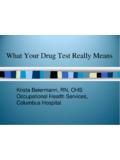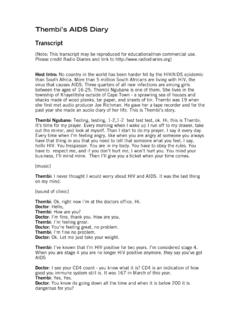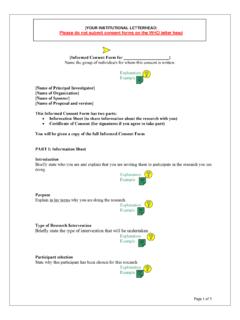Transcription of What should I know about my cardiac nuclear stress …
1 lexiscan is a prescription drug given through an IV line that increases blood flow through the arteries of the heart during a cardiac nuclear stress test. lexiscan is given to patients when they are unable to exercise adequately for a stress Considerations: lexiscan should not be given to patients who have certain abnormal heart rhythms unless they have a see imPortant safety information on Page 17. Please see full Prescribing information at should I know about my cardiac nuclear stress test with lexiscan ?2 Please see imPortant safety information on Page arterynormal artery33 Coronary artery diseaseWhat is coronary artery disease?The heart is a specialized muscle. Like other muscles in your body, it needs oxygen and nutrients. The coronary (heart) arteries deliver oxygen and nutrients to your heart so that it can effectively pump blood throughout your body.
2 People with heart disease may have one or more coronary arteries that have become narrowed or clogged over time by fatty deposits (also called plaques). These can decrease blood flow to the heart. Page 2 is an illustration that shows you what a healthy artery looks like compared with an unhealthy less blood flow is bad, right?Exactly. Reduced blood flow may cause chest pain (angina), shortness of breath, and potentially a heart attack. Injured heart muscle can be permanently damaged if the coronary arteries stay blocked for too long. If there is a problem with your heart, it is important to find out about it as soon as doctor scheduled me for an MPI test. What is it?MPI stands for myocardial perfusion imaging (MPI). The myocardium is your heart muscle. Perfusion refers to blood flow. And imaging is exactly what it sounds like, taking pictures. So, myocardial perfusion imaging is basically just taking pictures of the blood flow to your heart.
3 MPI is also called a cardiac nuclear stress test. It provides detailed images that can be used to diagnose and assess coronary artery , but how common is it?Very common. In fact, more than 3 million people had this test performed on them last year. It helps physicians see if there s a problem with your see full Prescribing information at see imPortant safety information on Page perfusion imaging5 Myocardial perfusion imagingDoes it hurt?Except for a small needle (catheter) that will be placed in a vein in your arm at the start of the test, MPI is a noninvasive test. That means it takes place outside of your body and does not involve surgery of any kind. You will stay awake and alert the entire small amount of radioactive liquid (called a tracer) will be injected into your bloodstream through the catheter during the MPI test. This tracer helps the doctor see the blood flow to your heart.
4 You probably will not feel any effects from the tracer, which your body eliminates by natural it s radioactive?Yes. Remember, radiation is always around us, from computers to wireless technology. Your doctor will make sure this is an appropriate test by looking at the amount of radiation you will be exposed to compared to your risks for heart disease. In many cases, not having this test may present higher risk than having it done. Okay, how do the pictures work? Is there a camera or something?Yes. A special camera will take pictures of your heart once the tracer moves through your arteries. Depending on the type of test, you may be required to have 2 sets of pictures taken by the camera at 2 different times (either later that day or even the next). These pictures give doctors detailed information about blood flow into your heart. They might see that some areas of your heart are blocked and not getting all the oxygen and nutrients they need.
5 This information will help your doctors decide what steps should be taken see full Prescribing information at ConsiderationsLexiscan can cause serious or fatal cardiac arrest, abnormal heart rhythms, heart attack, or serious allergic reactions. Trained staff should be immediately available while you are receiving perfusion imagingPlease see imPortant safety information on Page 17. Please see full Prescribing information at will the test be monitored?Your MPI test will be done under the supervision of your heart imaging team, which may consist of a doctor, a certified technologist and/or a registered nurse. In addition to the catheter, electrocardiograph (ECG) leads will be placed on your upper body, and a blood pressure cuff will be used to check your blood pressure. These are all normal monitoring procedures during the test. What else happens during an MPI test?
6 To help the tracer move quickly through your body and to your heart, it is necessary to get more blood flowing to your heart. This can often be achieved by walking briskly on a treadmill. This test is known as exercise stress . If for any reason, you are not able to exercise on the treadmill for your MPI test, your doctor may prescribe a medication that will be given through the catheter to increase blood flow to your heart. This procedure is called pharmacologic stress and it s used millions of times a year to help produce accurate images. Really? That seems like a , there are any number of reasons why someone may be unable to exercise adequately for an MPI test. Age, obesity, arthritis, diabetes, even chronic kidney disease can make exercise see. What s the drug called?There are a few different pharmacologic stress agents available, but the most commonly used one is called lexiscan (regadenoson) ConsiderationsDrugs such as lexiscan may cause an increase or decrease in blood pressure especially in patients with certain heart and blood vessel can cause breathing difficulties.
7 Before receiving lexiscan , tell your doctor if you have respiratory diseases, such as COPD (chronic obstructive pulmonary disease) or asthma. Tell your doctor about all medications you use to manage these (regadenoson) injection9 Please see imPortant safety information on Page 17. Please see full Prescribing information at (regadenoson) injectionWhat does lexiscan do exactly? lexiscan is a prescription drug given through an IV line that increases blood flow through the arteries of the heart during a cardiac nuclear stress test. lexiscan is given to patients when they are unable to exercise adequately for a stress will lexiscan be given?Well, you may be lying down on a hospital cart or sitting in a chair when you receive lexiscan (regadenoson) injection. A nurse or other certified lab professional will inject the lexiscan , and then the tracer, through the catheter that is already in your arm.
8 You ll feel the effects of the lexiscan almost s important to understand, whether you exercise on a treadmill or receive lexiscan stress , the goal is the same: to increase blood flow to your heart so that the tracer is completely distributed throughout your heart for accurate are the most common side effects with lexiscan ?The most common side effects that occurred in clinical trials of lexiscan were shortness of breath, headache, flushing, chest discomfort or chest pain, dizziness, nausea, abdominal discomfort, a metallic taste in the mouth, and feeling hot. Most common side effects began soon after receiving lexiscan and went away within 15 minutes except for headache which resolved in most patients within 30 effects are expected, so be sure to tell the physician or lab personnel how you re feeling. Remember, these effects usually go away within minutes.
9 After you receive lexiscan , you ll be ready for the images to be taken. Please see imPortant safety information on Page nuclear imaging camera11 Please see full Prescribing information at do I need to do during the imaging part of the test?For the best possible images of your heart, just do your best to relax and stay still. The goal is to be sure you are as comfortable as possible during the procedure. You may still be feeling the effects of lexiscan when you re ready for the images to be taken. This is expected. During the imaging part of the test, you ll rest on your back with your arms above your head. The camera will take images of your heart for about 20 to 40 minutes. It s very important that you re comfortable so that you can be as still as possible so that the camera can produce the best images. The camera is large, but don t worry. It won t touch your body and it doesn t hurt.
10 The nuclear imaging cameraSafety Considerations Avoid consuming any caffeine-containing foods and beverages or medicines containing methylxanthines (eg, caffeine or theophylline) in the 12 hours before your scheduled heart scan. Ask your doctor if you should stop taking any medications you usually take before the day of the are encouraged to report negative side effects of prescription drugs to the FDA. Visit or call see imPortant safety information on Page nuclear images13 The nuclear imagesYou mentioned that there might be two sets of images. How does that work?One set of images will be taken after the treadmill exercise or after you ve received pharmacologic stress . You may have another set of images taken while you re at rest. Comparing these two sets of images makes it easier for your doctor to see if any parts of your heart are not getting enough happens after the test?








